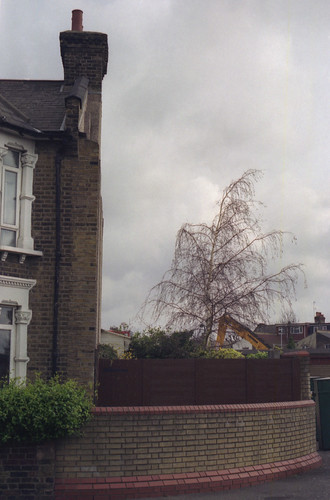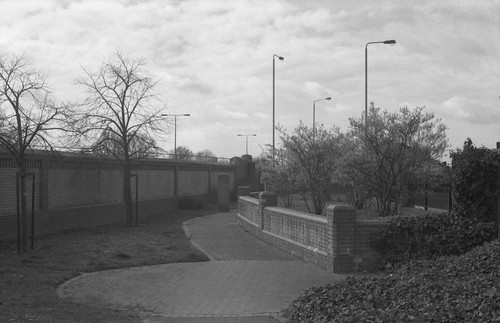 |
| Dyers Hall Road, 26th March 1994 |
The first frame was of an industrial building on Grove Green Road, close to Leytonstone Station. On a map from 1950, this is marked 'printing works'. Looking back, I find I have no memory of what it was like to exit Leytonstone Station then, something I didn't think to photograph. Just past this short section of Grove Green Road outside the station, Church Lane ran underneath the railway to join up with the high street, something I don't remember; there is now a playground on the open space of the junction. Placing the first photograph from 26th March 1994, I relied on Tim Brown's photographs on Flickr: this particular building appears in a photograph (taken three days after I was there) alongside C&M Apostolides Ltd, which has a clear road number on its sign, locating the building in my photograph securely. I didn't know about Tim Brown's pictures in 2014 when I returned to revisit my images; the photograph below, taken on Grove Green Road in 2014 is very broadly in the same area, but not exactly the same view.
The next photographs are on Dyers Hall Road, where I took many of my pictures. There are three photographs of the house on the corner which I had first photographed on 31st December, then in the process of being demolished, rather more easy to replicate in 2014.
In my photograph from December 1993 of this particular house, one can see a blue plaque on the house (see Retracings), reading 'Our heritage–this house was once a home', an artwork by Paul Noble. This was evidently retrieved from the demolition: it appears in Fieldstudy No.9, and is listed there as being in the Museum of London.
The next two photographs, one appearing at the head of this post, show a house on Dyers Hall Road that I had photographed on 18th February (see Photographs Not Taken), the end surviving building on the row backing onto the Central Line before the footbridge. The contemporary view simply shows the brick wall running alongside the A12.
There's a second photograph from Grove Green Road, after Dyers Hall Road rejoins it. This is a garage, which in 2014 I couldn't really place: the buildings on this side of Grove Green Road were demolished, but enough space remained after the road was built to create a long and narrow park, fittingly called the Linear Park. In 2014 there was a wall and railings separating the park from the road, which have now been removed and a cycle lane installed alongside the pavement that runs along it. I took a few photographs at different positions: not clear which might be the right one, I chose one with trees in blossom to stand in for the unknown precise location.
The last photograph is hard to place, a detail of a doorway of a demolished house. It could conceiveably have been on the section of Grove Green Road which is now the Linear Park, but I think it's more likely to be on Colville Road, possibly close to the Langthorne Road bridge, now a foot and cycle bridge. The 2014 photograph is again that of the brick wall along the A12 (the top of the footbridge can just be seen above the wall to the right).
The eight photographs taken on 26th March 1994 were the last I took for a number of months; this was at the start of the Easter holiday, so I wasn't travelling past the route of the road on the Central Line everyday, seeing the progression of the houses being demolished; shortly after being back at college for the summer term, my camera, a Praktica BC1 jammed. I was quoted £60 to send it away to be looked at without a guarantee that it could be fixed. It had cost £50 secondhand, a Christmas present, and so I was without a camera for a number of weeks until I found a Praktica BCA body for £26 to replace the body of the BC1 (the Bank of England inflation calculator shows these prices to be just double that today).































